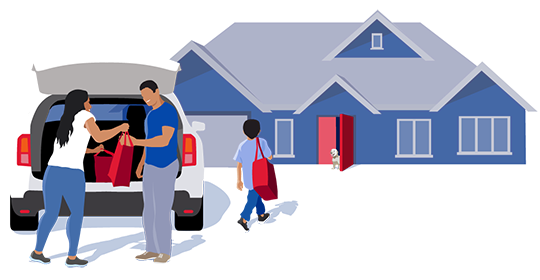Protect what matters most with a home insurance policy you can tailor to your life.
Homeowners insurance is there to help you ease the financial burden of repairing or rebuilding your home and replacing your belongings after commonplace disasters — a fire, lightning strike, tornado or even a break-in. It also can help cover your costs in a lawsuit over an injury — if, say, your dog bites a guest or your tree damages your neighbor’s car.
What does homeowners insurance cover?
A standard homeowners insurance policy covers damage to your home and your property caused by various perils covered by the policy. Typical home insurance policies cover damage caused by:
- An aircraft, car or other vehicle
- Explosions
- Falling objects
- Fire and smoke
- Lightning strikes
- Theft
- Vandalism and malicious mischief
- Some types of water damage
- The weight of ice, snow and sleet
- Windstorms and hail
What are the types of homeowners insurance?
In most states, standard homeowners insurance policies provide four main types of coverage.
Dwelling coverage helps you pay for repairs or rebuilding your home if it’s damaged or destroyed.
Personal property coverage helps you pay the costs of fixing or replacing your belongings if they’re damaged.
Liability coverage helps you protect your financial assets if you’re at fault for an injury or property damage.
Additional living expenses coverage helps you pay for rent, food and other increased costs if you have to live somewhere else while your home is being repaired.
Learn more about other types of home insurance coverage that may be right for you.
What coverage is required or suggested in my state?
Home insurance is not required by law, but if you have a mortgage, your lender can require you to have insurance until the loan is paid off. (Learn more about home insurance coverage by state.)
And there are other reasons to insure your home. If your home is damaged or destroyed in a disaster (think: tornado, kitchen fire, hailstorm), insurance can help you pay to repair or replace your home and belongings. Liability coverage in a homeowners policy also helps you protect your personal assets from costly lawsuits if you are sued and found responsible for damage or injury to others.
How much homeowners insurance do I need?
One way to estimate how much home insurance you might need: multiply the total square footage of your home by per-square-foot building costs in your area. (A local real estate agent, contractor or builders’ association should be able to give you a ballpark amount of local building costs.)
In addition to estimating the cost to rebuild your home, consider how much it will cost to:
Replace your belongings
Defray additional living expenses if you can’t live in your home
Protect your financial assets if you are sued
How much does homeowners insurance cost?
The average premium for an HO-3 policy, the most common homeowners policy, is around $1,115 per year for a package (including dwelling, property and liability coverage) with an insurance range of $200,000-$299,000, according to a January 2021 report from the National Association of Insurance Commissioners.
But there are many details that factor into the actual cost of a home insurance policy, including where you live, the type of home you live in and how much coverage you choose. Talk to a Farmers agent to learn more about your coverage options and available discounts.
Bundling auto and home insurance can also save you money. If you already have one policy with Farmers®, see how much you could save by bundling more.
View home insurance coverage in your state
Select your state to see types and requirements
Learn From Experience
Helping homeowners plan and prepare so you can protect what matters most.
Is Home Insurance Required If I Own a Home?
Home insurance isn’t required by law, but there are other reasons to insure your home.

How Can I Save Money on My Home Insurance?
One of the most cost-efficient things you can do is combine all your policies with the same insurer.

Does Home Insurance Cover My Foundation?
Whether foundation repairs are covered depends on the source of the damage. Every part of your home, including the foundation, is subject to wear and tear over the years.

